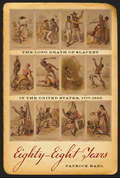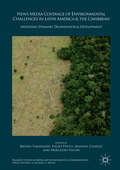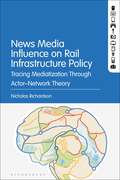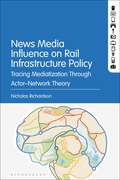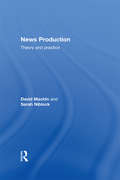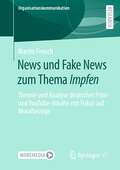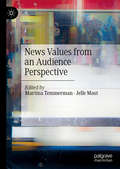- Table View
- List View
The News Media At War: The Clash of Western and Arab Networks in the Middle East (Library of Modern Middle East Studies #Vol. 125)
by Tarek CherkaouiDuring the 2003 War in Iraq, American news media found it difficult to convey their pro-war perspective outside the United States. Since the war was unpopular in many parts of the world, failure to win hearts and minds - particularly in the Middle East - represented a significant setback for the American soft power.
News Media Coverage of Environmental Challenges in Latin America and the Caribbean: Mediating Demand, Degradation and Development (Palgrave Studies in Media and Environmental Communication)
by Bruno Takahashi Juliet Pinto Manuel Chavez Mercedes VigónThis edited collection provides a unique survey of the ways in which news media organizations across Latin America and the Caribbean cover global, regional and local environmental issues and challenges. There is growing recognition within academia, governments, industries, NGOs and civil society about the importance of strategic communication and the news media in informing current societal and policy discussions about environmental issues. With this in mind, this volume explores the content of reporting as well as the structural and individual contests faced by media organizations and journalists, with a focus on the very unique political, social, cultural and environmental conditions that affect the countries individually. The book provides a survey of the most relevant and current environmental issues that have attracted public attention across the region and within countries in Latin America and the Caribbean in the first part of the 21st century.This volume will be of interest to students, instructors and researchers interested in Latin America and the Caribbean, media and the environment.
News Media in the Arab World: A Study of 10 Arab and Muslim Countries
by Barrie Gunter Roger DickinsonNews Media in the Arab World: A Study of 10 Arab and Muslim Countries is based on ongoing research at the Department of Media and Communication, University of Leicester, and has investigated the rapidly changing nature of the news media in Arab countries. They have investigated the role of newspapers and television in news provision and the impact of new media developments, most especially the emergence of the internet as a platform for news distribution and of international satellite television channels such as Al Jazeera. Examining the constantly developing nature of news, the collection contains separately authored chapters produced by the researchers responsible for each original analysis, covering Bahrain, Egypt, Iraq, Kuwait, Libya, Oman, Qatar, Palestine, Saudi Arabia and the United Arab Emirates. Based on original primary and secondary research, this will be the first empirical-based collection to blend perspectives from both the Western and Arab nations.
News Media in the Arab World: A Study of 10 Arab and Muslim Countries
by Barrie Gunter Roger DickinsonNews Media in the Arab World: A Study of 10 Arab and Muslim Countries is based on ongoing research at the Department of Media and Communication, University of Leicester, and has investigated the rapidly changing nature of the news media in Arab countries. They have investigated the role of newspapers and television in news provision and the impact of new media developments, most especially the emergence of the internet as a platform for news distribution and of international satellite television channels such as Al Jazeera. Examining the constantly developing nature of news, the collection contains separately authored chapters produced by the researchers responsible for each original analysis, covering Bahrain, Egypt, Iraq, Kuwait, Libya, Oman, Qatar, Palestine, Saudi Arabia and the United Arab Emirates. Based on original primary and secondary research, this will be the first empirical-based collection to blend perspectives from both the Western and Arab nations.
News Media Influence on Rail Infrastructure Policy: Tracing Mediatization Through Actor–Network Theory
by Nicholas RichardsonIn this book, Richardson's research spans a decade and two cities - Sydney, Australia and Montreal, Canada - focusing on three metro-style rail infrastructure case study projects: one ongoing, one failed and one upgraded after reaching fifty years of age – to build an irrefutable case that the news media is highly influential to policy, and that these influences are complex, messy and changing.News Media Influence on Rail Infrastructure Policy offers scholars and industry practitioners in the arenas of policy analysis, politics and media communications a method for astutely guiding large-scale projects through the complex and changing landscape of 24/7 news media. It is underpinned by empirical research that identifies and endeavors to close a considerable gap in current understanding and practice. This gap represents a failure to recognise and respect mediatization – the many powerful influences impacting a policy arena that has drawn the ire of the news media. The result of this failure is ineffective communication that does little to advance the policy piece and, in the worst instances, leads to policy immobilisation or poor policy decision-making.Drawing significantly on Actor–Network Theory, Richardson identifies the influential actors and alliances at play when policy is subjected to media discourse, and he proposes a framework for tracing and managing them. In doing so, he demonstrates that such a framework is not only vital for the successful negotiation of policy and projects in the media, but also to an (r)evolutionary recasting of public, expert and media actors in the development and decision-making process.
News Media Influence on Rail Infrastructure Policy: Tracing Mediatization Through Actor–Network Theory
by Nicholas RichardsonIn this book, Richardson's research spans a decade and two cities - Sydney, Australia and Montreal, Canada - focusing on three metro-style rail infrastructure case study projects: one ongoing, one failed and one upgraded after reaching fifty years of age – to build an irrefutable case that the news media is highly influential to policy, and that these influences are complex, messy and changing.News Media Influence on Rail Infrastructure Policy offers scholars and industry practitioners in the arenas of policy analysis, politics and media communications a method for astutely guiding large-scale projects through the complex and changing landscape of 24/7 news media. It is underpinned by empirical research that identifies and endeavors to close a considerable gap in current understanding and practice. This gap represents a failure to recognise and respect mediatization – the many powerful influences impacting a policy arena that has drawn the ire of the news media. The result of this failure is ineffective communication that does little to advance the policy piece and, in the worst instances, leads to policy immobilisation or poor policy decision-making.Drawing significantly on Actor–Network Theory, Richardson identifies the influential actors and alliances at play when policy is subjected to media discourse, and he proposes a framework for tracing and managing them. In doing so, he demonstrates that such a framework is not only vital for the successful negotiation of policy and projects in the media, but also to an (r)evolutionary recasting of public, expert and media actors in the development and decision-making process.
News Media Innovation Reconsidered
by María Luengo Susana Herrera-DamasA guide to journalistic ethics for today’s digital technologies With contributions from an international panel of experts on the topic, News Media Innovation Reconsidered offers a guide for the revitalizing of the ethical and civil ideals of journalism. The authors discuss how to energize journalistic practices and products and explore how to harness the power of digital technological innovations such as immersive journalism, the automatization and personalization of news, newsgames, and artificial-intelligence news production. The book presents an innovative framework of “creative reconstruction” and reviews new journalistic concepts, models, initiatives, and practices that clearly demonstrate professional ethics that embrace truth seeking, transparency, fact checking, and accuracy, and other ethical considerations. While the contributors represent numerous countries, many of examples are drawn from the Spanish-speaking media and can serve as models for an international audience. This important book: Explores the impact on the news media from mobile-first, virtual reality, and artificial intelligence-driven platforms Examines the challenges of maintaining journalistic ethics in today’s digital world Demonstrates how to use technology to expose readers to news outside their comfort zones Provides information for discerning truth from fake news Written for researchers, students in journalism and communication programs, New Media Innovation Reconsidered offers a much-needed guide for recreating journalistic ethics in our digital age.
News Media Innovation Reconsidered: Ethics and Values in a Creative Reconstruction of Journalism
by María Luengo Susana Herrera-DamasA guide to journalistic ethics for today’s digital technologies With contributions from an international panel of experts on the topic, News Media Innovation Reconsidered offers a guide for the revitalizing of the ethical and civil ideals of journalism. The authors discuss how to energize journalistic practices and products and explore how to harness the power of digital technological innovations such as immersive journalism, the automatization and personalization of news, newsgames, and artificial-intelligence news production. The book presents an innovative framework of “creative reconstruction” and reviews new journalistic concepts, models, initiatives, and practices that clearly demonstrate professional ethics that embrace truth seeking, transparency, fact checking, and accuracy, and other ethical considerations. While the contributors represent numerous countries, many of examples are drawn from the Spanish-speaking media and can serve as models for an international audience. This important book: Explores the impact on the news media from mobile-first, virtual reality, and artificial intelligence-driven platforms Examines the challenges of maintaining journalistic ethics in today’s digital world Demonstrates how to use technology to expose readers to news outside their comfort zones Provides information for discerning truth from fake news Written for researchers, students in journalism and communication programs, New Media Innovation Reconsidered offers a much-needed guide for recreating journalistic ethics in our digital age.
NEWS MEDIA WENK C: What Everyone Needs to Know® (What Everyone Needs To Know®)
by Leonard Downie Michael Schudson C.W. AndersonThe business of journalism has an extensive, storied, and often romanticized history. Newspaper reporting has long shaped the way that we see the world, played key roles in exposing scandals, and has even been alleged to influence international policy. The past several years have seen the newspaper industry in a state of crisis, with Twitter and Facebook ushering in the rise of citizen journalism and a deprofessionalization of the industry, plummeting readership and revenue, and municipal and regional papers shuttering or being absorbed into corporate behemoths. Now billionaires, most with no journalism experience but lots of power and strong views, are stepping in to purchase newspapers, both large and small. This addition to the What Everyone Needs to Know® series looks at the past, present and future of journalism, considering how the development of the industry has shaped the present and how we can expect the future to roll out. It addresses a wide range of questions, from whether objectivity was only a conceit of late twentieth century reporting, largely behind us now; how digital technology has disrupted journalism; whether newspapers are already dead to the role of non-profit journalism; the meaning of "transparency" in reporting; the way that private interests and governments have created their own advocacy journalism; whether social media is changing journalism; the new social rules of old media outlets; how franchised media is addressing the problem of disappearing local papers; and the rise of citizen journalism and hacker journalism. It will even look at the ways in which new technologies potentially threaten to replace journalists.
News Narratives And News Framing: Constructing Political Reality (PDF) (Communication, Media, And Politics Ser.)
by Karen S. Johnson-CarteeNews Narratives and News Framing is a revealing look at how the media's construction of news affects our political, economic, and social realities. In this introduction to the theory behind news framing, Karen Johnson-Cartee pulls together elements from communication, journalism, politics, and sociology to create a picture of how news forms these realities for the public. With its comprehensive reference section and suggestions on how to influence the news agenda, this is a beneficial resource for students in political communication, media criticism, and communication theory.
News, Numbers and Public Opinion in a Data-Driven World
by An NguyenFrom the quality of the air we breathe to the national leaders we choose, data and statistics are a pervasive feature of daily life and daily news. But how do news, numbers and public opinion interact with each other – and with what impacts on society at large? Featuring an international roster of established and emerging scholars, this book is the first comprehensive collection of research into the little understood processes underpinning the uses/misuses of statistical information in journalism and their socio-psychological and political effects. Moving beyond the hype around "data journalism," News, Numbers and Public Opinion delves into a range of more latent, fundamental questions such as: · Is it true that most citizens and journalists do not have the necessary skills and resources to critically process and assess numbers? · How do/should journalists make sense of the increasingly data-driven world? · What strategies, formats and frames do journalists use to gather and represent different types of statistical data in their stories? · What are the socio-psychological and political effects of such data gathering and representation routines, formats and frames on the way people acquire knowledge and form attitudes? · What skills and resources do journalists and publics need to deal effectively with the influx of numbers into in daily work and life – and how can newsrooms and journalism schools meet that need? The book is a must-read for not only journalists, journalism and media scholars, statisticians and data scientists but also anybody interested in the interplay between journalism, statistics and society.
News, Numbers and Public Opinion in a Data-Driven World
by An NguyenFrom the quality of the air we breathe to the national leaders we choose, data and statistics are a pervasive feature of daily life and daily news. But how do news, numbers and public opinion interact with each other – and with what impacts on society at large? Featuring an international roster of established and emerging scholars, this book is the first comprehensive collection of research into the little understood processes underpinning the uses/misuses of statistical information in journalism and their socio-psychological and political effects. Moving beyond the hype around “data journalism," News, Numbers and Public Opinion delves into a range of more latent, fundamental questions such as: · Is it true that most citizens and journalists do not have the necessary skills and resources to critically process and assess numbers? · How do/should journalists make sense of the increasingly data-driven world? · What strategies, formats and frames do journalists use to gather and represent different types of statistical data in their stories? · What are the socio-psychological and political effects of such data gathering and representation routines, formats and frames on the way people acquire knowledge and form attitudes? · What skills and resources do journalists and publics need to deal effectively with the influx of numbers into in daily work and life – and how can newsrooms and journalism schools meet that need? The book is a must-read for not only journalists, journalism and media scholars, statisticians and data scientists but also anybody interested in the interplay between journalism, statistics and society.
News of Baltimore: Race, Rage and the City (Routledge Research in Journalism)
by Linda SteinerThis book examines how the media approached long-standing and long-simmering issues of race, class, violence, and social responsibility in Baltimore during the demonstrations, violence, and public debate in the spring of 2015. Contributors take Baltimore to be an important place, symbol, and marker, though the issues are certainly not unique to Baltimore: they have crucial implications for contemporary journalism in the U.S. These events prompt several questions: How well did journalism do, in Baltimore, nearby and nationally, in explaining the endemic issues besetting Baltimore? What might have been done differently? What is the responsibility of journalists to anticipate and cover these problems? How should they cover social problems in urban areas? What do the answers to such questions suggest about how journalists should in future cover such problems?
News of Baltimore: Race, Rage and the City (Routledge Research in Journalism)
by Linda Steiner Silvio WaisbordThis book examines how the media approached long-standing and long-simmering issues of race, class, violence, and social responsibility in Baltimore during the demonstrations, violence, and public debate in the spring of 2015. Contributors take Baltimore to be an important place, symbol, and marker, though the issues are certainly not unique to Baltimore: they have crucial implications for contemporary journalism in the U.S. These events prompt several questions: How well did journalism do, in Baltimore, nearby and nationally, in explaining the endemic issues besetting Baltimore? What might have been done differently? What is the responsibility of journalists to anticipate and cover these problems? How should they cover social problems in urban areas? What do the answers to such questions suggest about how journalists should in future cover such problems?
The News of the World and the British Press, 1843-2011: 'Journalism for the Rich, Journalism for the Poor' (Palgrave Studies in the History of the Media)
by Chandrika Kaul Mark W. Turner Laurel BrakeThis volume is the first scholarly treatment of the News of the World from news-rich broadsheet to sensational tabloid. Contributors uncover new facts and discuss a range of topics including Sunday journalism, gender, crime, empire, political cartoons, the mass market, investigative techniques and the Leveson Inquiry.
News Production: Theory and Practice
by Sarah Niblock David MachinBringing to the forefront a much-needed book that bridges the gap between journalistic theory and practice, Sarah Niblock and David Machin provide here an invaluable real-life account of reporting in the context of contemporary newsrooms. Providing eight detailed ethnographies of eight different news production settings, News Production includes individual chapters that follow two news workers through their daily routines, detailing the exact nature of their jobs. It provides students with: case studies to compare to their own experiences concrete examples to consolidate their skill-based training questions to raise about their placements information on how to prepare reports constraints they may encounter, and how to deal with them. With chapters including ‘News Agencies’, ‘The Roving Reporter’, ‘Photojournalism’ and ‘The New Reporter Learning the Ropes’, for anyone taking practical units in news reporting, sub-editing, and law and ethics, News Production will provide them with all the information they need to succeed in this hectic, competitive and exciting world.
News Production: Theory and Practice
by Sarah Niblock David MachinBringing to the forefront a much-needed book that bridges the gap between journalistic theory and practice, Sarah Niblock and David Machin provide here an invaluable real-life account of reporting in the context of contemporary newsrooms. Providing eight detailed ethnographies of eight different news production settings, News Production includes individual chapters that follow two news workers through their daily routines, detailing the exact nature of their jobs. It provides students with: case studies to compare to their own experiences concrete examples to consolidate their skill-based training questions to raise about their placements information on how to prepare reports constraints they may encounter, and how to deal with them. With chapters including ‘News Agencies’, ‘The Roving Reporter’, ‘Photojournalism’ and ‘The New Reporter Learning the Ropes’, for anyone taking practical units in news reporting, sub-editing, and law and ethics, News Production will provide them with all the information they need to succeed in this hectic, competitive and exciting world.
News Quality in the Digital Age (Media and Power)
by Regina G. Lawrence Philip M. NapoliThis book brings together a diverse, international array of contributors to explore the topics of news “quality” in the online age and the relationships between news organizations and enormously influential digital platforms such as Facebook, Google, and Twitter. Covering topics ranging from internet incivility, crowdsourcing, and YouTube politics to regulations, algorithms, and AI, this book draws the key distinction between the news that facilitates democracy and news that undermines it. For students and scholars as well as journalists, policymakers, and media commentators, this important work engages a wide range of methodological and theoretical perspectives to define the key concept of “quality” in the news media.
News Quality in the Digital Age (Media and Power)
by Regina G. Lawrence Philip M. NapoliThis book brings together a diverse, international array of contributors to explore the topics of news “quality” in the online age and the relationships between news organizations and enormously influential digital platforms such as Facebook, Google, and Twitter. Covering topics ranging from internet incivility, crowdsourcing, and YouTube politics to regulations, algorithms, and AI, this book draws the key distinction between the news that facilitates democracy and news that undermines it. For students and scholars as well as journalists, policymakers, and media commentators, this important work engages a wide range of methodological and theoretical perspectives to define the key concept of “quality” in the news media.
News und Fake News zum Thema Impfen: Theorie und Analyse deutscher Print- und YouTube-Inhalte mit Fokus auf Moralbezüge (Organisationskommunikation)
by Martin FenschDesinformation, Fake News zerstören Vertrauen und ver- oder behindern die rekonstruktive Konstruktion von Wirklichkeit mit weitreichenden Folgen für das individuelle Lernen und das gesellschaftliche Handeln. Die Arbeit beschreibt und definiert vor dem Hintergrund einer theoretisch-analytischen Auseinandersetzung mit dem Wahrheitsbegriff das Realphänomen der Fake News. Im empirischen Teil wird die deutschsprachige Impfkommunikation der Jahre 2018-2019 in ausgewählten Printmedien und auf YouTube im Rahmen einer Inhaltsanalyse unter anderem auf Fake News hin untersucht. Ebenfalls wird die Moral Foundations Theory genutzt, um moralische Inhaltsbezüge zu dekodieren und ihren Zusammenhang mit Fake News herzustellen. Kapitel zur Gesundheitskommunikation und zur Geschichte der Impfgegner bieten weiteren Kontext zur Deutung der Ergebnisse.
News Values from an Audience Perspective
by Martina Temmerman Jelle MastThis book focuses on journalistic news values from an audience perspective. The audience influences what is deemed newsworthy by journalists, not only because journalists tell their stories with a specific audience in mind, but increasingly because the interaction of the audience with the news can be measured extensively in digital journalism and because members of the audience have a say in which stories will be told. The first section considers how thinking about news values has evolved over the last fifty years and puts news values in a broader perspective by looking at news consumers’ preferences in different countries worldwide. The second section analyses audience response, explaining how audience appreciation and ‘clicking’ behaviour informs headline choices and is measured by algorithms. Section three explores how audiences contribute to the creation of news content and discusses mainstream media’s practice of recycling audience contributions on their own social media channels.
Newsmaking Cultures in Africa: Normative Trends in the Dynamics of Socio-Political & Economic Struggles
by Hayes Mawindi Mabweazara Cleophas Taurai MuneriThis book contributes to a broadened theorisation of journalism by exploring the intricacies of African journalism and its connections with the material realities that underpin the profession on the continent. It pulls together theoretically driven studies that collectively deploy a wide range of evidence to shed some light on newsmaking cultures in Africa – the everyday routines, defining epistemologies, as well as ethical dilemmas. The volume digs beneath the standardised and universalised veneer of professionalism to unpack routine practices and normative trends shaped by local factors, including the structural conditions of deprivation, entrenched political instability (and interference), pervasive neo-patrimonial governance systems, and the influences of technological developments. These varied and complex circumstances are shown to profoundly shape the foundations of journalism in Africa, resulting in routine practices that are both normatively distinct and equally in tune with (imported) Western journalistic cultures. The book thus broadly points to the dialectical nature of news production and the inconsistent and contradictory relationships that characterise news production cultures in Africa.
The Newspaper Axis: Six Press Barons Who Enabled Hitler
by Kathryn S. OlmstedHow six conservative media moguls hindered America and Britain from entering World War II “A landmark in the political history of journalism.”—Michael Kazin, author of What It Took to Win: A History of the Democratic Party As World War II approached, the six most powerful media moguls in America and Britain tried to pressure their countries to ignore the fascist threat. The media empires of Robert McCormick, Joseph and Eleanor Patterson, and William Randolph Hearst spanned the United States, reaching tens of millions of Americans in print and over the airwaves with their isolationist views. Meanwhile in England, Lord Rothermere’s Daily Mail extolled Hitler’s leadership and Lord Beaverbrook’s Daily Express insisted that Britain had no interest in defending Hitler’s victims on the continent. Kathryn S. Olmsted shows how these media titans worked in concert—including sharing editorial pieces and coordinating their responses to events—to influence public opinion in a right-wing populist direction, how they echoed fascist and anti‑Semitic propaganda, and how they weakened and delayed both Britain’s and America’s response to Nazi aggression.
Newspaper Building Design and Journalism Cultures in Australia and the UK: 1855-2010 (Routledge Research in Journalism)
by Carole O'Reilly Josie VineThis book examines the micro-cultural ideologies of the journalism profession in Britain and Australia by focusing on the design, execution and development of newspaper building architecture. Concentrating on the main newspaper buildings in the major metropolitan areas in Australia (Melbourne, Sydney, Adelaide) and the UK (Manchester, London, Edinburgh and Liverpool) from 1855 to 2010, Newspaper Building Design interweaves a rich analysis of spatial characteristics of newspaper offices with compelling anecdotes from journalists’ working lives, to examine the history, evolution and precarious future of the physical newsroom and the surrounding interior and exterior space. The book argues that newspaper buildings are designed to accommodate and extend journalism’s professional values and belief systems over time and that their architecture reflects ideological change and continuity in these value and belief systems, such as the evolution from trade to profession. Ancillary factors, such as the influence of the newspapers’ owners on the building design and the financing of new structures are also considered. As professional practice rapidly shifts out of the newspaper offices, this insightful study questions what this may mean for the future of the industry. Newspaper Building Design will benefit academics and researchers in the areas of media, journalism, cultural studies and urban history.
Newspaper Building Design and Journalism Cultures in Australia and the UK: 1855–2010 (Routledge Research in Journalism)
by Carole O'Reilly Josie VineThis book examines the micro-cultural ideologies of the journalism profession in Britain and Australia by focusing on the design, execution and development of newspaper building architecture. Concentrating on the main newspaper buildings in the major metropolitan areas in Australia (Melbourne, Sydney, Adelaide) and the UK (Manchester, London, Edinburgh and Liverpool) from 1855 to 2010, Newspaper Building Design interweaves a rich analysis of spatial characteristics of newspaper offices with compelling anecdotes from journalists’ working lives, to examine the history, evolution and precarious future of the physical newsroom and the surrounding interior and exterior space. The book argues that newspaper buildings are designed to accommodate and extend journalism’s professional values and belief systems over time and that their architecture reflects ideological change and continuity in these value and belief systems, such as the evolution from trade to profession. Ancillary factors, such as the influence of the newspapers’ owners on the building design and the financing of new structures are also considered. As professional practice rapidly shifts out of the newspaper offices, this insightful study questions what this may mean for the future of the industry. Newspaper Building Design will benefit academics and researchers in the areas of media, journalism, cultural studies and urban history.
